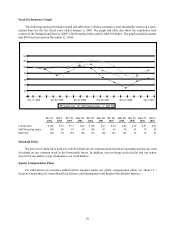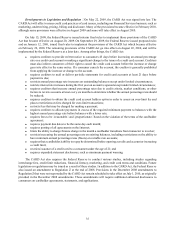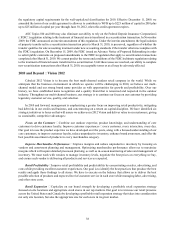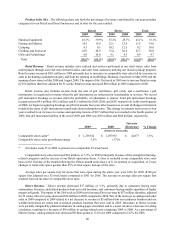Cabela's 2009 Annual Report Download - page 47
Download and view the complete annual report
Please find page 47 of the 2009 Cabela's annual report below. You can navigate through the pages in the report by either clicking on the pages listed below, or by using the keyword search tool below to find specific information within the annual report.38
the regulatory capital requirements for the well-capitalized classification for 2010. Effective December 11, 2009, we
amended the terms of our credit agreement to allow us to contribute to WFB up to $225 million of capital in 2010 plus
up to $25 million of capital per year through June 30, 2012, when this credit agreement expires.
ASC Topics 810 and 860 may also eliminate our ability to rely on the Federal Deposit Insurance Corporation’s
(“FDIC”) regulation relating to the treatment of financial assets transferred in a securitization transaction. In November
2009, the FDIC announced an interim amendment of this regulation. Under the interim amendment, the legal isolation
of property transferred in a securitization transaction prior to March 31, 2010, is preserved, regardless of whether the
transfer qualifies for sale accounting treatment under new accounting standards if the transfer otherwise complies with
the FDIC’s regulation. On December 15, 2009, the FDIC issued an Advance Notice of Proposed Rulemaking in order
to solicit public comments on proposed amendments to the FDIC’s regulation that apply to securitization transactions
completed after March 31, 2010. We cannot predict the terms and conditions of the FDIC’s ultimate regulation relating
to the treatment of financial assets transferred in a securitization. Until these issues are resolved, our ability to complete
new securitization transactions after March 31, 2010, on acceptable terms or at all may be adversely affected.
2010 and Beyond – Vision 2012
Cabela’s 2012 Vision is to become the best multi-channel outdoor retail company in the world. While we
anticipate that the business environment in which we operate will be challenging in 2010, we believe our multi-
channel model and our strong brand name provides us with opportunities for growth and profitability. Over our
history, we have established name recognition and a quality brand that is renowned and respected in the outdoor
industry. Throughout our multi-channel business, our strategy is to continue our focus on our customer by providing
legendary customer service, quality, and selection.
In 2010 and forward, management is emphasizing a greater focus on improving retail productivity, mitigating
bad debt risk in our credit card business, and concentrating on a return on capital discipline. We have identified six
strategic initiatives to focus on that will assure we achieve our 2012 Vision and deliver value to our customers, giving
us sustainable, competitive advantages:
Focus on the Customer – Combine our outdoor expertise, product knowledge, and understanding of core
customers to drive customer loyalty. Improve customer experiences – every customer, every interaction, every day.
Our goal is to use the product expertise we have developed over the years, along with a focused understanding of our
core customers, to improve customer loyalty, reduce unproductive inventory, enhance brand awareness, and offer the
best possible assortment of products in every merchandise category.
Improve Merchandise Performance – Improve margins and reduce unproductive inventory by focusing on
vendors and assortment planning and management. Optimizing merchandise performance allows us to maximize
margins which will require detailed preseason planning, as well as in-season monitoring of sales and management of
inventory. We must work with vendors to manage inventory levels, negotiate the best prices on everything we buy,
and ensure each vendor is delivering all products and services as expected.
Retail Profitability – Improve retail profitability and predictability by concentrating on sales, advertising, and
costs while providing excellent customer experiences. Our goal is to identify the best practices that produce the best
results and apply those findings to all stores. We have to execute on the balance that allows us to deliver the best
possible selection of products and expected level of customer service in each store while managing labor, advertising,
and other store costs.
Retail Expansion – Capitalize on our brand strength by developing a profitable retail expansion strategy
focused on site locations and appropriate sized stores in our top markets. Our goal is to increase our retail presence
across the United States and Canada by developing a profitable retail expansion strategy that takes into consideration
not only site location, but also the appropriate size for each store in its given market.
























